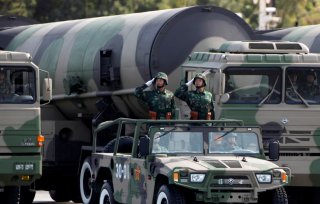The Danger of an Inadequate Nuclear Threat Assessment
Every U.S. operational plan in the Department of Defense rests on the assumption that strategic nuclear deterrence will hold.
But if the United States did expand its SNDVs, it would take decades and hundreds of billions more defense costs. Although having one thousand ICBMs, more than thirty submarines with 480 missiles, and some sixty-plus strategic bombers on strip alert would markedly improve the strategic balance. For example, the future seven to one ratio of Russian and Chinese strategic warheads to U.S. nuclear assets would no longer be the threat, but with a ratio closer to three to one.
In short, do numbers matter and is improving stability possible? In the early Reagan administration, multiple National Security defense directives sought an end to the Soviet empire and a more secure and stable nuclear balance. How? A ban on multiple-warhead land-based missiles, moving more nuclear forces to sea on survivable submarines, preserving America’s dual-use strategic bombers for their critically needed conventional mission, in addition to robust missile defenses and major reductions in arms through arms control agreements.
It’s no secret that Soviet political leaders had elaborate plans to strike NATO and particularly the United States pre-emptively. But during the Reagan administration, surviving U.S. nuclear capabilities, even after a “successful” Soviet first strike, was over two thousand U.S. nuclear weapons. This was a formidable deterrent, more credible than the estimated four hundred to five hundred retaliatory warheads that might be the minimal deterrent under the unreasonable assumptions a person can make today.
The commander of U.S. Strategic Command, Adm. Charles Richard said on August 12, 2021, that America is “witnessing a strategic breakout by China . . . The explosive growth in their nuclear and conventional forces can only be what I described as breathtaking." He added that “frankly, that word ‘breathtaking’ may not be enough.” Richard characterized China as a “peer” nuclear competitor and noted that we now face two nuclear “peer” competitors, Russia, and China, compared to one during the Cold War.
The United States did previously build during the Reagan era three hard-target-kill-capable missiles able to take out key Soviet military targets, including the Soviet reserve ICBM force. But the five hundred Peacekeeper warheads the Reagan administration deployed are retired, the remaining highly capable four hundred high-yield W-88 sea-based warheads may not hold all newly hardened targets at risk, while the advanced cruise missile has also been eliminated. The remaining Minuteman ICBM force is much improved but reportedly not necessarily capable of taking out super hard thirty thousand psi concrete silos.
But the United States is still nearly a decade away before the modernized platforms enter the deterrent force. What is needed is a full analysis of whether the planned nuclear force, (much less a smaller one), can deal with the newly expanding Chinese and Russian nuclear forces, including deeply buried hardened targets, many defended by advanced defenses.
Richard explains that every U.S. operational plan in the Department of Defense rests on the assumption that strategic nuclear deterrence will hold. Also, he notes that if strategic nuclear deterrence doesn’t hold, then “none of our other plans, and no other capability that we have is going to work as designed. We can’t afford to have nuclear deterrence fail.”
Peter Huessy is the director of Strategic Deterrent Studies at the Mitchell Institute for Aerospace Studies.
Image: Reuters

